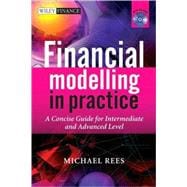
What is included with this book?
Since 2002 Michael has worked independently as a consultant and trainer in financial modelling. Prior to this he worked as a strategy consultant with Braxton Associates and Mercer Management Consulting, and also as an analyst at J.P. Morgan.
Michael lives in Richmond, UK. He was born in Canada, has lived in several countries, and is fluent in French and German.
| Background, Objectives and Approach | |
| About The Author | |
| Acknowledgements | |
| Building Blocks: Selected Excel Functions and Tools | |
| Core Functions for Financial Modelling | |
| Arithmetic Operations | |
| Logical Operations | |
| Financial Calculations | |
| Database Functions, Features and Pivot Tables | |
| Statistical Functions | |
| Lookup and Reference Functions | |
| Text Functions | |
| Information Functions | |
| Array Functions, Formulae and Matrix Calculations | |
| GoalSeek and Solver | |
| The Analysis ToolPak and Other Add-ins | |
| Selected Excel Short-cuts | |
| Principles of Modelling | |
| What is a Good Model? | |
| Model Design | |
| Selection of Model Variables and their Dependencies | |
| Level of Detail or Aggregation | |
| Model Structure and Planning | |
| Logical FlowCompactness | |
| Named Ranges | |
| Circular References | |
| Model Building | |
| Formatting and Comments | |
| Creating Robust Formulae | |
| Results Presentation and Other Uses of Sensitivity Analysis | |
| General Remarks on Presentation | |
| Using Data Tables to Conduct Sensitivity Analysis | |
| Hiding and Protecting Models | |
| Model Auditing | |
| Financial Statement, Cash Flow and Valuation Modelling | |
| Financial Statement Modelling: Core Points and Example | |
| General Comments | |
| Income Statement Forecasting | |
| Balance Sheet Forecasting | |
| Cash Flow Statement Forecasting | |
| Error Checks and Feasibility Checks | |
| General Error Checking Tools | |
| Feasibility Checking and Ratio Analysis | |
| Adding Generality | |
| Cash Flow Valuation | |
| Calculation of Free Cash Flow | |
| Discounting Free Cash Flow | |
| Terminal Value Calculations | |
| Further Adjustments | |
| Sensitivity Analysis | |
| Risk Modelling | |
| Benefits and Challenges of Risk Modelling | |
| The Risk Modelling Process | |
| An Introduction to Simulation Techniques | |
| The Language of Probability Distributions | |
| Quick Guide to using @RISK | |
| Types of Dependency Relationships in Risk Models | |
| The Selection and Use of Distributions | |
| Pragmatic Approaches and Distributions | |
| Data-Driven Approaches and Distributions | |
| Scientific Approaches and Distributions: The Basics | |
| Further Aspects of the Science of Distributions | |
| Further Example Models | |
| Introduction to Options and Real Options Modelling | |
| Financial Market Derivatives: An Introduction | |
| Real Options Modelling | |
| Uses and Relationships to Other Types of Analysis | |
| Examples using Simulation | |
| Examples using Trees | |
| VBA for Financial Modelling | |
| Introduction | |
| The Bare Essentials | |
| Simple Examples | |
| Building Blocks | |
| Working with Ranges | |
| Writing Robust Code | |
| Further Topics | |
| Object Orientation: An Introduction | |
| Controlling Execution and Related Topics | |
| Working with Functions | |
| Checking and Debugging Code | |
| Examples: Recording Macros and Related Topics | |
| Introduction | |
| Using GoalSeek and Solver | |
| Examples: Simulation Modelling | |
| Introduction | |
| Examples: User-defined Functions | |
| Creating Functions | |
| Examples | |
| Structure and Organisation: Further Topics | |
| Further Reading | |
| Table of Contents provided by Publisher. All Rights Reserved. |
The New copy of this book will include any supplemental materials advertised. Please check the title of the book to determine if it should include any access cards, study guides, lab manuals, CDs, etc.
The Used, Rental and eBook copies of this book are not guaranteed to include any supplemental materials. Typically, only the book itself is included. This is true even if the title states it includes any access cards, study guides, lab manuals, CDs, etc.